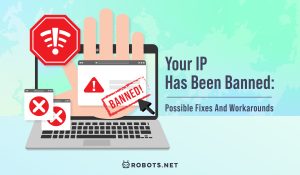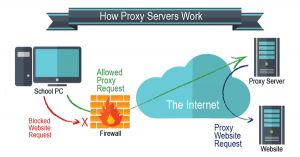Introduction
Welcome to the world of IP bans: when your access to a website or service is blocked based on your IP address. IP bans are commonly used by websites, online platforms, and even game servers to restrict access for various reasons. Whether you’ve been banned from a popular social media platform, an online forum, or a streaming service, being locked out can be frustrating.
However, don’t lose hope just yet! There are ways to get around an IP ban and regain access to the blocked website or service. In this article, we will explore different methods that can help you change your IP address and bypass these bans.
Before we dive into the solutions, it’s important to understand how IP bans work. Every device connected to the internet has an IP address, which is a unique identifier assigned by your Internet Service Provider (ISP). When you visit a website or service, the server logs your IP address, allowing them to track your activity and enforce bans if necessary.
IP bans can be implemented for various reasons. Website administrators may use them to prevent spam, protect against malicious activities, enforce region-specific restrictions, or enforce terms of service violations. While these bans may serve a purpose, they can also affect innocent users who are mistakenly or unfairly blocked.
Fortunately, there are several methods you can try to get around an IP ban and regain access. From changing your IP address using a VPN or proxy server to configuring your router and clearing browser cookies, we will cover the most effective techniques in this article. Keep in mind that while these methods can be successful, they may not guarantee access in every situation. Additionally, it’s important to respect the rules and terms of service of the website or service you’re trying to access.
Now that we have a basic understanding of IP bans and their implications, let’s explore the different methods you can use to bypass them. Whether you’re a social media enthusiast, an avid gamer, or someone seeking unrestricted access to websites, our solutions will help you regain control over your online experience.
Understanding IP Bans
Before we delve into how to get around IP bans, it’s important to have a clear understanding of what they are and why they occur. An IP ban, or Internet Protocol ban, is a restriction placed on your IP address by a website or online service. This ban prevents you from accessing their content or services.
Website administrators and service providers often implement IP bans for a variety of reasons. One common reason is to combat spam and malicious activities. By blocking certain IP addresses associated with spam or suspicious behavior, websites can protect themselves and their users from potential threats.
Another reason for implementing an IP ban is to enforce region-specific restrictions. Some websites or streaming services may limit access to certain content based on the user’s geographical location. In such cases, an IP ban is used to restrict access for users outside the allowed regions.
Furthermore, IP bans can be enforced to manage and control user behavior. In online forums and communities, administrators may use IP bans to prevent trolls or individuals who repeatedly violate the community guidelines from accessing the platform.
It’s important to understand that an IP ban can affect multiple users if they share the same IP address. In certain cases, a ban on one user’s IP address can inadvertently block other users as well. This often happens in shared network environments such as schools or workplaces, where multiple devices connect to the internet using a single IP address.
It’s worth mentioning that IP bans are not foolproof, and determined individuals may find ways to bypass them. However, it’s essential to exercise caution and respect the rules of the website or service you’re attempting to access. Bypassing an IP ban without just cause or in violation of terms of service can have legal consequences.
Now that we have a clearer understanding of what IP bans are and why they are implemented, let’s explore the different methods you can use to change your IP address and bypass these restrictions. Whether you’re facing an IP ban on a social media platform, a gaming server, or any other online service, we’ve got you covered. Let’s get started!
Changing Your IP Address
If you’re facing an IP ban and need to regain access, one of the most effective methods is to change your IP address. By doing so, you can bypass the ban and access the blocked website or service. Here are a few methods you can try:
1. Using a VPN: A Virtual Private Network (VPN) is a popular tool for changing your IP address and encrypting your online traffic. VPNs allow you to connect to servers in different locations, effectively masking your true IP address. By choosing a server in a location where the ban is not enforced, you can access the desired website or service. Keep in mind that free VPNs may have limitations, so it’s recommended to invest in a reliable paid VPN service for optimal performance and security.
2. Using a Proxy Server: Proxy servers act as intermediaries between your device and the website or service you’re trying to access. They mask your IP address and route your internet traffic through a different IP address. There are various free and paid proxy servers available, each with its own specifications. It’s important to choose a reliable proxy server that offers good speed and security to ensure a seamless browsing experience.
3. Configuring Your Router: If you have access to your router’s settings, you can try changing your IP address by releasing and renewing your IP lease. This process may vary depending on your router model, so consult the user manual or the manufacturer’s website for specific instructions. By obtaining a new IP address from your ISP, you can bypass the ban.
4. Restarting Your Modem: Sometimes, simply restarting your modem can result in a new IP address being assigned to your device. To do this, unplug your modem from the power source and wait for a few minutes. Then, plug it back in and let it restart. Once your modem has fully rebooted, check your IP address to see if it has changed. This method works best if you have a dynamic IP address, which is the case for most residential internet connections.
5. Clearing Your Browser Cookies: In some cases, IP bans are tied to cookies stored on your browser. By clearing your browser cookies, you can remove the ban and access the blocked content. However, keep in mind that clearing cookies will also remove saved login information and preferences from websites you visit regularly.
Remember, while these methods can be effective in changing your IP address and bypassing IP bans, they may not guarantee access in every situation. Additionally, using these methods to circumvent bans that are in place for valid reasons or in violation of terms of service is not recommended. Always respect the rules and policies of the websites and services you’re trying to access.
Now that you have a better understanding of how to change your IP address, let’s move on to exploring more methods to get around IP bans.
Using a VPN
One of the most popular and effective methods to bypass an IP ban is by using a Virtual Private Network (VPN). A VPN works by encrypting your internet traffic and routing it through a server located in a different location, effectively changing your IP address and masking your true location. Here’s how you can use a VPN to get around an IP ban:
1. Choose a reputable VPN provider: There are many VPN providers available, both free and paid. It’s crucial to choose a reputable and reliable provider that offers a wide range of server locations, good connection speeds, and robust security features. Look for VPNs that have positive user reviews and a strong track record in privacy and security.
2. Install the VPN software: Once you’ve chosen a VPN provider, download and install their VPN software or app onto your device. Most VPN providers offer software for various devices and operating systems, including Windows, macOS, iOS, and Android.
3. Launch the VPN application: Open the VPN software and log in using your account credentials. Depending on the VPN provider, you may have the option to select a server location manually or let the VPN choose the best server for you.
4. Connect to a server: Choose a server location where the IP ban is not enforced. For example, if you’re unable to access a website from your current location, try connecting to a server in a different country or region where the ban doesn’t apply.
5. Verify your new IP address: After connecting to the VPN server, your IP address will be changed to the IP address of the server location you selected. To verify that your IP address has changed, you can use online tools or visit websites that display your current IP address.
6. Access the blocked content: Once you have successfully connected to a VPN server and changed your IP address, you should be able to access the blocked website or service. Your online traffic will be encrypted, ensuring your privacy and allowing you to bypass the IP ban without being detected.
Using a VPN not only helps you bypass IP bans but also provides additional benefits such as enhanced online security, privacy, and anonymity. However, it’s important to note that the effectiveness of a VPN may vary depending on the website or service you’re trying to access. Some websites actively block VPN traffic, so you might need to try different servers or VPN providers to find one that works.
Remember to choose a VPN provider that aligns with your privacy and security needs. Paid VPN services generally offer more features and better performance compared to free VPNs. Additionally, keep in mind that using a VPN to engage in illegal activities or violate the terms of service of a website is not recommended and may have legal consequences.
Now that you know how to use a VPN to get around an IP ban, let’s explore another method: using a proxy server.
Using a Proxy Server
Another effective method to bypass an IP ban is by using a proxy server. A proxy server acts as an intermediary between your device and the website or service you’re trying to access. It masks your IP address and routes your internet traffic through a different IP address, helping you bypass the ban. Here’s how you can use a proxy server:
1. Find a reliable proxy server: There are both free and paid proxy servers available online. It’s important to choose a reliable and reputable proxy server that offers good speed and security. Look for websites or services that provide a list of available proxy servers, along with details on their location and performance.
2. Configure your device to use the proxy server: Once you’ve found a suitable proxy server, you’ll need to configure your device to use it. The method for configuring a proxy server may vary depending on your device and operating system. Typically, you can find the proxy settings in the network or internet settings of your device. Enter the IP address and port number of the proxy server to establish the connection.
3. Choose a server location: Some proxy servers offer multiple server locations to choose from. If the IP ban is based on your geographical location, try selecting a server location where the ban is not enforced. This will allow you to access the blocked content successfully.
4. Verify your new IP address: After configuring the proxy server, your IP address will be changed to the IP address of the proxy server. You can verify this by using online tools or visiting websites that display your current IP address.
5. Access the blocked website or service: With the proxy server configured and your IP address changed, you should now be able to access the blocked website or service. Your internet traffic will be routed through the proxy server, making it appear as if you’re browsing from the server’s location instead of your own.
Using a proxy server can be an effective method to bypass IP bans, especially when the ban is based on geographical location. However, it’s important to note that not all websites or services can be accessed using a proxy server. Some websites have advanced security measures in place to detect and block proxy server traffic. In such cases, you may need to try different proxy servers or consider using other methods, such as a VPN.
Additionally, it’s important to choose a proxy server that prioritizes privacy and security. Free proxy servers may come with limitations, such as slower speeds, limited server locations, and potential privacy risks. Paid proxy services often offer more features and better performance, along with enhanced privacy protections.
Now that you’re familiar with using a proxy server to bypass IP bans, let’s explore another method: configuring your router.
Configuring Your Router
If you have access to your router’s settings, you can try changing your IP address by configuring your router. By releasing and renewing the IP lease from your Internet Service Provider (ISP), you can obtain a new IP address and potentially bypass the IP ban. Here’s how you can configure your router to change your IP address:
1. Access your router’s settings: To make changes to your router, you’ll need to access its administrative settings. Open a web browser on a device connected to the router’s network and enter the router’s default IP address in the address bar. Typically, the default IP address is something like 192.168.0.1 or 192.168.1.1. You can find your router’s IP address in the router’s documentation or by searching for it online.
2. Enter your router’s login credentials: Once you’ve accessed the router’s login page, enter the username and password to log in. If you haven’t changed the login credentials, you can usually find the default username and password in the router’s documentation or on the manufacturer’s website. If you have changed the login credentials and don’t remember them, you may need to perform a factory reset on the router.
3. Navigate to the DHCP settings: Inside the router’s settings, look for the DHCP (Dynamic Host Configuration Protocol) settings. This is where you’ll find the option to release and renew your IP lease.
4. Release and renew your IP lease: In the DHCP settings, you’ll usually find an option to release the current IP lease. Click on this option to release your current IP address. Afterward, look for an option to renew the IP lease. By renewing the lease, your ISP will assign you a new IP address, which can potentially bypass the IP ban.
5. Verify your new IP address: Once you’ve released and renewed the IP address lease, you can verify whether your IP address has changed. Visit an online IP address checking tool or access a website that displays your current IP address. If the IP address displayed is different from your previous one, it means your router configuration was successful, and you now have a new IP address.
6. Access the blocked website or service: With your router’s IP address changed, you should be able to access the blocked website or service. The new IP address assigned to your network will be different from the one that was previously banned, allowing you to bypass the IP ban.
It’s important to note that not all routers have the same configuration options, and the steps above may vary slightly depending on your router’s brand and model. If you’re unsure about making changes to your router’s settings, it’s advisable to consult the router’s manual or contact the manufacturer’s support for guidance.
Keep in mind that changing your IP address by configuring your router may not guarantee successful access to the blocked website or service in all cases. Some IP bans may be more sophisticated and not solely based on IP address. In such cases, you may need to try other methods, such as using a VPN or proxy server.
Now that you know how to configure your router to change your IP address, let’s move on to another method: restarting your modem.
Restarting Your Modem
If you’re facing an IP ban and need to change your IP address, one simple yet effective method is to restart your modem. By power cycling your modem, you can potentially obtain a new IP address from your Internet Service Provider (ISP), allowing you to bypass the IP ban. Here’s how you can restart your modem to change your IP address:
1. Locate the power source: Find the power source that is supplying electricity to your modem. This is usually a power outlet or a power strip.
2. Turn off the modem: Locate the power button or switch on your modem and turn it off. If there is no power button or switch, simply unplug the power adapter from the power source.
3. Wait for a few minutes: Leave your modem powered off for at least a few minutes. This will allow enough time for the device to fully shut down and reset its connection with your ISP.
4. Power on the modem: After waiting for a few minutes, plug the power adapter back into the power source or turn on the power switch/button on your modem. Allow the modem a few moments to fully boot up and establish a connection with your ISP.
5. Verify your new IP address: Once your modem has fully restarted and established a connection, you can verify whether your IP address has changed. Visit an online IP address checking tool or access a website that displays your current IP address. If the displayed IP address is different from your previous one, it means your modem restart was successful, and you now have a new IP address.
6. Access the blocked website or service: With your modem restarted and a new IP address assigned, you should now be able to access the blocked website or service. The new IP address obtained from your ISP will bypass the previous IP ban.
It’s important to note that restarting your modem may not always guarantee a new IP address. Some ISPs use static IP addresses, which means the IP address assigned to you remains the same even after a restart. In such cases, this method may not work to bypass the IP ban.
Additionally, if you have multiple devices connected to the same modem, restarting the modem will affect the internet connection for all devices. Make sure to inform other users connected to the same network about the temporary disruption in internet service.
If restarting your modem doesn’t result in a new IP address or doesn’t successfully bypass the IP ban, you can try other methods such as using a VPN, proxy server, or contacting your Internet Service Provider (ISP) for assistance.
Now that you know how to change your IP address by restarting your modem, let’s explore another method to bypass IP bans: clearing your browser cookies.
Clearing Your Browser Cookies
If you’re facing an IP ban and need to regain access to a blocked website or service, one method you can try is clearing your browser cookies. Sometimes, IP bans are tied to cookies stored on your browser, so by removing these cookies, you can reset your browsing session and potentially bypass the IP ban. Here’s how you can clear your browser cookies:
1. Access your browser settings: Open your web browser and navigate to the settings menu. The location of the settings menu may vary depending on the browser you’re using. Typically, you can find it by clicking on the three-dot menu icon or by accessing the browser’s “Preferences” or “Options” menu.
2. Locate the “Privacy” or “History” section: Once you’re in the settings menu, find the section related to privacy or browsing history. In this section, you’ll find the option to manage your cookies and clear them.
3. Clear your cookies: Look for the option to clear your browser’s cookies or browsing data. Depending on the browser, you may have the option to select specific time ranges or types of data to clear. To effectively bypass the IP ban, select the option to clear cookies. You can also choose to clear other browsing data such as cache and history for a more thorough reset.
4. Restart your browser: After clearing your cookies, it’s recommended to restart your web browser. This will ensure that all previous session data is completely removed, including any saved cookies or information related to the IP ban.
5. Access the blocked website or service: Once your browser has restarted, navigate to the blocked website or service again. With your cookies cleared, your browsing session will be reset, potentially allowing you to bypass the IP ban and access the content or service.
Keep in mind that clearing your cookies will also remove any saved login information, preferences, or personalized settings associated with websites you regularly visit. You may need to log back into websites and set up any customizations again after clearing your cookies.
It’s important to note that clearing your cookies may not guarantee a successful bypass of the IP ban in all cases. Some IP bans may be tied to other factors, such as your IP address or other tracking mechanisms. In such cases, you may need to try other methods, such as using a VPN or proxy server.
Now that you know how to clear your browser cookies to potentially bypass an IP ban, let’s explore another method: using a mobile hotspot.
Using a Mobile Hotspot
If you’re facing an IP ban and need an alternative way to access a blocked website or service, using a mobile hotspot can be a viable solution. By connecting your device to a mobile hotspot, you can utilize your mobile data connection and bypass the IP ban associated with your home network. Here’s how you can use a mobile hotspot:
1. Enable mobile hotspot on your smartphone: If you have a smartphone with a mobile data plan, you can enable the mobile hotspot feature. This allows your smartphone to act as a wireless access point, providing internet connectivity to other devices.
2. Configure mobile hotspot settings: Access the settings on your smartphone and navigate to the mobile hotspot or tethering section. Here, you can configure the network name (SSID) and password for your hotspot. Make sure to choose a strong password to ensure the security of your hotspot.
3. Connect your device to the mobile hotspot: On the device you want to connect, such as a laptop or another smartphone, enable Wi-Fi and search for available networks. Select your smartphone’s hotspot network from the list and enter the password when prompted. Once connected, your device will use the mobile data connection from your smartphone.
4. Verify your new IP address: With your device connected to the mobile hotspot, you should have a different IP address compared to your home network. Visit an online IP address checking tool or access a website that displays your current IP address to verify the change.
5. Access the blocked website or service: Now that you’re using a different IP address through the mobile hotspot, you can attempt to access the blocked website or service. Your connection will be using the mobile data network, bypassing any IP bans associated with your home network.
Using a mobile hotspot can be an effective method to bypass IP bans, especially if the ban is specifically targeted at your home network’s IP address. However, it’s important to consider the limitations of your mobile data plan, as excessive usage may result in additional charges or speed throttling.
Keep in mind that mobile network providers may have their own restrictions and limitations on hotspot usage. Before using your mobile hotspot extensively, it’s advisable to review your plan’s terms and conditions or contact your mobile network provider for more information.
If you don’t have access to a mobile hotspot, you can explore other methods such as using a VPN, proxy server, or contacting your Internet Service Provider (ISP) for assistance in changing your IP address and bypassing the IP ban.
Now that you understand how to use a mobile hotspot to bypass IP bans, let’s explore one more method: contacting your Internet Service Provider (ISP) for assistance.
Contacting Your Internet Service Provider (ISP)
If you’ve tried various methods to bypass an IP ban without success, or if you believe the ban is unjust or unfair, contacting your Internet Service Provider (ISP) can be a helpful course of action. Your ISP is responsible for assigning your IP address and managing your internet connection, so they may have the ability to assist you in resolving the IP ban. Here’s how you can contact your ISP for assistance:
1. Gather necessary information: Before contacting your ISP, gather any relevant information regarding the IP ban. This may include the name of the website or service that has blocked your IP address, the error message you receive, and any other pertinent details that can help explain the situation.
2. Locate contact details: Find the contact details for your ISP’s customer support. This information is typically available on their website, billing statements, or in the documentation provided when you signed up for their service.
3. Speak with customer support: Reach out to your ISP’s customer support and explain the issue you’re facing with the IP ban. Be polite and provide them with the necessary information you gathered in the previous step. Describe the problem clearly and ask if they can assist in resolving the issue.
4. Follow their guidance: Depending on the situation, the customer support representative may provide you with steps to change your IP address or troubleshoot the issue. Follow their guidance and instructions carefully to ensure the best chance of resolving the IP ban.
5. Escalate the issue, if necessary: If the initial customer support representative is unable to resolve the IP ban or provide a satisfactory solution, ask to escalate the issue to a higher level of support. This may involve speaking with a supervisor or submitting a formal complaint through their designated process.
6. Be patient and persistent: Resolving IP bans can sometimes be a complex process, and it may require time and persistence on your part. Stay patient and continue to communicate with your ISP until the issue is resolved.
It’s important to note that not all ISPs may be able to assist with IP bans, especially if the ban is imposed by a third-party website or service. In such cases, your ISP may not have direct control over the IP ban or the ability to change your IP address.
Additionally, it’s crucial to approach your ISP respectfully and understand that they have their own policies and procedures to follow. While they may endeavor to assist you, they may also have limitations in what they can do.
If contacting your ISP doesn’t lead to a resolution, you can explore other methods such as using a VPN, proxy server, or alternative internet connections to bypass the IP ban. Remember to always respect the rules and policies of the websites or services you’re trying to access and use these methods responsibly.
Now that you understand how to contact your ISP for assistance with an IP ban, let’s conclude our exploration of methods to bypass IP bans.
Conclusion
Dealing with an IP ban can be frustrating, especially when it restricts your access to websites or services that you rely on. However, with the methods we’ve explored in this article, you have several options to bypass these bans and regain access to the content you need. Let’s recap the methods we discussed:
1. Changing your IP address using a VPN: A VPN allows you to connect to servers in different locations, effectively masking your true IP address and bypassing the ban.
2. Using a proxy server: Proxy servers act as intermediaries between your device and the blocked website or service, changing your IP address and allowing you to access the content.
3. Configuring your router: By releasing and renewing the IP lease from your ISP, you can obtain a new IP address and potentially bypass the IP ban.
4. Restarting your modem: Power cycling your modem can result in a new IP address being assigned to your device, allowing you to bypass the IP ban.
5. Clearing your browser cookies: By removing cookies stored on your browser, you can reset your browsing session and potentially bypass the IP ban associated with them.
6. Using a mobile hotspot: Connect your device to a mobile hotspot to utilize a different IP address and bypass the IP ban associated with your home network.
7. Contacting your Internet Service Provider (ISP): If all else fails, reach out to your ISP’s customer support for assistance in resolving the IP ban.
It’s important to note that while these methods can be effective, they may not guarantee access in every situation. The effectiveness of each method depends on various factors, such as the specific circumstances of the IP ban and the technical capabilities of the websites or services involved.
Additionally, it’s essential to use these methods responsibly and in compliance with the rules and terms of service of the websites or services you’re accessing. Misusing these methods can have legal consequences and may also impact the experience of other users.
Remember to consider the security and privacy implications of the methods you choose. VPNs and proxy servers can provide additional security and encryption, while public Wi-Fi networks and mobile hotspots may introduce potential risks. Always prioritize your digital security when accessing the internet.
With these methods at your disposal, you have the flexibility and knowledge to overcome IP bans and regain access to the content you desire. Experiment with these methods and find the one that works best for your situation. Stay informed, adapt to changing circumstances, and keep enjoying your online experience free from unnecessary restrictions.












![10 Best Non-Blocked Torrent Sites To Try Now [2020 Edition]](https://robots.net/wp-content/uploads/2019/08/torrent-35656_1280-170x170.png)












